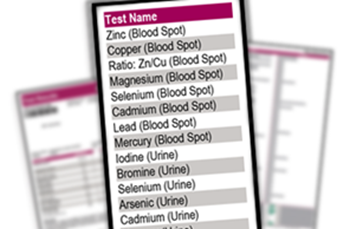Blood Test To Check Mercury Levels
Significant exposure is indicated when the whole blood mercury is above 50 ngmL if exposure is due to alkyl Hg or above 200 ngmL if exposure is due to Hg2. Ask your healthcare provider what your test results mean for you.

Mercury In Fish Detoxmetals In 2021 Mercury In Fish High Mercury Fish Heavy Metal
Perhaps the most accepted method for testing for mercury toxicity among alternative practitioners is called the urine porphyrin test however this test has been neglected and even criticized by.

Blood test to check mercury levels. The mercury blood test measures your exposure to mercury. Your test results may not mean you have a problem. In my book The Autoimmune Solution I detail the testing options available for mercury exposure.
Metals that are less commonly tested for include copper zinc aluminum and thallium. The results of this test are given in micrograms per liter mcgL. What medical testing is used to detect mercury exposure.
This blood test monitors levels of mercury commonly found in industrial factories old paint and some types of fish. Having some mercury in your blood does not mean you will develop health problems. Mercury is an element and heavy metal with a wide range of industrial and environmental uses.
The most common metals tested for are lead mercury arsenic and cadmium. Normal whole blood mercury is usually below 10 ngmL. It is ordered to determine if there has been an acute or chronic exposure to high levels of mercury.
Sometimes referred to as quicksilver mercury is used in common devices like thermometers. However exposure to large amounts of mercury or chronic exposure over a. Acute and chronic mercury poisoning affects the kidneys central nervous system and the gastrointestinal tract.
Patients typically develop other problems as well such as hair loss with thallium. The mercury test also known as a mercury lab test mercury level test mercury poisoning test and mercury toxicity test measures the mercury blood level. Organic mercury poisoning is best detected in whole blood as this form of mercury is located mainly in the RBCs.
A heavy metal blood test is a group of tests that measure the levels of potentially harmful metals in the blood. Organic compounds predominantly affect the central nervous system CNS and effects may be severe and irreversible. Organic mercury poisoning may develop quickly and is usually a more serious disease.
Normal levels of mercury in blood and urine indicate that it is likely that the patient has not been exposed to excessive levels of mercury at least not in the window of time that the test is measuring. Specifically the mercury blood test detects the level of methyl mercury in the blood. Other forms of mercury can also be detected in the blood but according to the Agency for Toxic Substances and Disease Registry ATSDR the amount present in blood will decrease by a half every 3 days as the mercury moves into other organs such as the brain and kidneys.
Most people are exposed to small amounts of mercury in the environment which do not cause health problems. Now the reason. This test is for anyone who is worried about mercury exposure either from the workplace environment or from certain dental fillings.
The most commonly accepted methods of assessing mercury exposure are to test urine or blood. Mercury level can also present in a urinalysis but this level also decreases over time. The test is done with a blood sample.
The three telltale symptoms of mercury poisoning are. Both tests usually measure levels of total mercury elemental inorganic and organic. A blood test indicates whether youve been exposed to mercury in the last few days.
However blood levels of certain types of mercury decrease rapidly within three to five days. These may be performed using urine or blood. Elevated mercury in urine usually indicates exposure to an elemental or inorganic source of mercury such as from a job that uses mercury.
This test measures Mercury levels in the blood. Organic mercury poisoning is best detected in blood as this form of mercury is located mainly in the red blood cells. This test can be influenced by eating fish because fish particularly certain deep sea fish may contain mercury.
Mercury Poisoning Blood Test. Elevated levels of mercury in blood or urine indicate that excessive exposure to mercury. Other types of mercury including metallic and inorganic mercury are detectable in the blood.
Red Blood Cell Test RBC The first is a blood panel called a red blood cell test or RBC in which the lab uses a blood sample to examine your heavy metal exposure for the past three months. ALA is the only chelator which can cross the blood brain barrier and can chelate mercury form inside the brain and other organs. Individuals who have mild exposure during work such as dentists may routinely have whole blood mercury levels up to 15 ngmL.
Normally levels are 10 mcgL or less. The mercury blood test is used to detect an excess of mercury. Studies conducted by the CDC 3 found that approximately 6 of childbearing-age women had levels at or above a reference dose an estimated level assumed to be without appreciable harm 58 μgL.
You can perform the test using alpha lipoic acid chelates mercury and arsenic DMSA chelates mercury and lead or DMPS chelates mercury and arsenic. However your blood mercury level decreases quickly within three to five days making this test nonconfirmatory. The mean mercury concentration levels in the general population in whole blood and urine were observed to be 18 μg L and 45 μg L respectively 7.
Blood is primarily tested to detect the presence of methyl mercury. Hair tests can give indications of long-term mercury exposure. Irregularity of muscular action.
Testing Options for Mercury Overload. High levels of lead mercury thallium zinc and arsenic or low levels of copper have all been associated with peripheral neuropathy. Information is power so testing can identify a potential cause of your health concerns and help guide you and your health professional in your treatment.
The most common nonindustrial source of mercury poisoning is the consumption of methyl mercury-contaminated fish. How is this test done. A blood test can demonstrate whether you have been presented with mercury in the last few days.
Testing for mercury levels in the blood will help you and your health professional either rule out potential toxicity or confirm that a high mercury level might be a health concern. Nonetheless in remarkably low concentration levels of mercury exposure the association between the exposure and blood or urine mercury concentration levels was low.

Mercury Detox Mercury Toxicity Testing And Methods

A Guide To Mercury Levels In Fish The Dr Oz Show

Elements Testing Why Sample Type Matters Zrt Laboratory

How You Can Reverse Your Type 2 Diabetes For Good I Should Introduce Myself Low Mercury Fish Tile Fish Recipe Fish Recipes

Posting Komentar untuk "Blood Test To Check Mercury Levels"